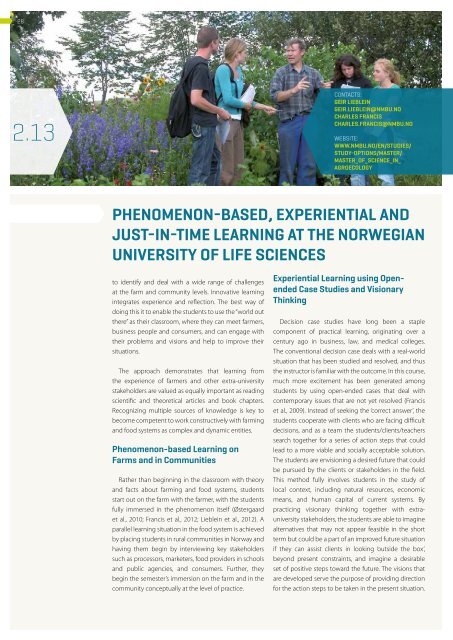tpo_dossier_action-plan-for-innovation-and-learning_201406
tpo_dossier_action-plan-for-innovation-and-learning_201406
tpo_dossier_action-plan-for-innovation-and-learning_201406
You also want an ePaper? Increase the reach of your titles
YUMPU automatically turns print PDFs into web optimized ePapers that Google loves.
282.13CONTACTS:GEIR LIEBLEINGEIR.LIEBLEIN@NMBU.NOCHARLES FRANCISCHARLES.FRANCIS@NMBU.NOWEBSITE:WWW.NMBU.NO/EN/STUDIES/STUDY-OPTIONS/MASTER/MASTER_OF_SCIENCE_IN_AGROECOLOGYPHENOMENON-BASED, EXPERIENTIAL ANDJUST-IN-TIME LEARNING AT THE NORWEGIANUNIVERSITY OF LIFE SCIENCESto identify <strong>and</strong> deal with a wide range of challengesat the farm <strong>and</strong> community levels. Innovative <strong>learning</strong>integrates experience <strong>and</strong> reflection. The best way ofdoing this it to enable the students to use the “world outthere” as their classroom, where they can meet farmers,business people <strong>and</strong> consumers, <strong>and</strong> can engage withtheir problems <strong>and</strong> visions <strong>and</strong> help to improve theirsituations.The approach demonstrates that <strong>learning</strong> fromthe experience of farmers <strong>and</strong> other extra-universitystakeholders are valued as equally important as readingscientific <strong>and</strong> theoretical articles <strong>and</strong> book chapters.Recognizing multiple sources of knowledge is key tobecome competent to work constructively with farming<strong>and</strong> food systems as complex <strong>and</strong> dynamic entities.Phenomenon-based Learning onFarms <strong>and</strong> in CommunitiesRather than beginning in the classroom with theory<strong>and</strong> facts about farming <strong>and</strong> food systems, studentsstart out on the farm with the farmer, with the studentsfully immersed in the phenomenon itself (Østergaardet al., 2010; Francis et al., 2012; Lieblein et al., 2012). Aparallel <strong>learning</strong> situation in the food system is achievedby placing students in rural communities in Norway <strong>and</strong>having them begin by interviewing key stakeholderssuch as processors, marketers, food providers in schools<strong>and</strong> public agencies, <strong>and</strong> consumers. Further, theybegin the semester’s immersion on the farm <strong>and</strong> in thecommunity conceptually at the level of practice.Experiential Learning using OpenendedCase Studies <strong>and</strong> VisionaryThinkingDecision case studies have long been a staplecomponent of practical <strong>learning</strong>, originating over acentury ago in business, law, <strong>and</strong> medical colleges.The conventional decision case deals with a real-worldsituation that has been studied <strong>and</strong> resolved, <strong>and</strong> thusthe instructor is familiar with the outcome. In this course,much more excitement has been generated amongstudents by using open-ended cases that deal withcontemporary issues that are not yet resolved (Franciset al., 2009). Instead of seeking the ‘correct answer’, thestudents cooperate with clients who are facing difficultdecisions, <strong>and</strong> as a team the students/clients/teacherssearch together <strong>for</strong> a series of <strong>action</strong> steps that couldlead to a more viable <strong>and</strong> socially acceptable solution.The students are envisioning a desired future that couldbe pursued by the clients or stakeholders in the field.This method fully involves students in the study oflocal context, including natural resources, economicmeans, <strong>and</strong> human capital of current systems. Bypracticing visionary thinking together with extrauniversitystakeholders, the students are able to imaginealternatives that may not appear feasible in the shortterm but could be a part of an improved future situationif they can assist clients in looking ‘outside the box’,beyond present constraints, <strong>and</strong> imagine a desirableset of positive steps toward the future. The visions thatare developed serve the purpose of providing direction<strong>for</strong> the <strong>action</strong> steps to be taken in the present situation.


